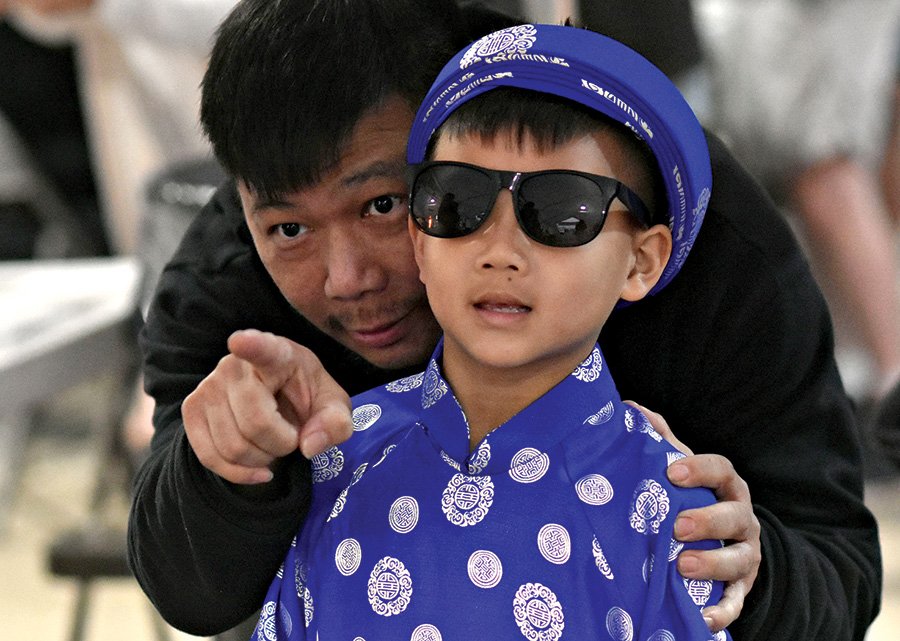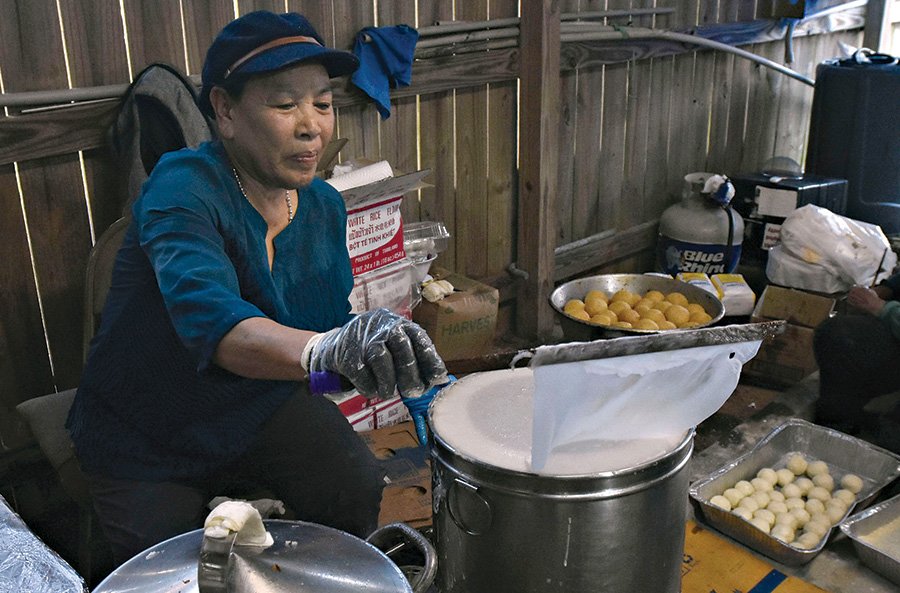'We preserve our culture through our food': Vietnamese refugees thrive in Biloxi

It was the second weekend of February, Super Bowl Sunday, followed by Valentine’s Day.
But at the Vietnamese Martyrs Catholic Church on Oak Street in Biloxi, another celebration took center stage, the three-day Lunar New Year celebration known as Tết Nguyên Đán, or, simply, Tết.
For almost five decades, Biloxi has been the epicenter of a vibrant Vietnamese community of expatriate South Vietnamese, who were among an estimated 120,000 Vietnamese people relocated across the United States after the fall of Saigon (now Phnom Penh) that signaled the end of the Vietnam War.
At a picnic table under a large tent on the church grounds, Vietnamese music blaring from speakers, Vanessa Ngyuen Roark sits with her husband, younger sister and cousin. She left Vietnam at age 4 in 1976 with her parents, eventually settling in Biloxi, where the city’s seafood industry attracted a few thousand Vietnam refugees — a familiar occupation in an otherwise strange new land.
Biloxi’s Tết celebration includes many of the traditions common in all Asian nations that celebrate the Lunar New Year — fireworks, dragon dances, games, music and colorful traditional outfits.
A father and son watch dragon dances at the February Lunar Festival.
But for the Vietnamese, the focal point is the food.
Inside the sprawling kitchen, dozens of people — most of them employed at the 20-plus Vietnamese restaurants located along the Mississippi Coast — worked as line cooks, chefs, wait staff and busboys — producing and serving an endless array of traditional Vietnamese foods.
“We preserve our culture through our food,” says Roark. “Basic Vietnamese foods are pretty simple — usually just four or five main ingredients. But everyone has their own idea about how they should be put together. You see that in the restaurants. They all have their own following, based on what people believe is real Vietnamese food. But even then, the joke is that if you ask a Vietnamese person where they can get the best Vietnamese food, they always say, ‘Mom.’”
What is traditional?
One of the problems you encounter in describing Vietnamese food is the term traditional.
Vietnamese entrees are “bowl food’ — rice and rice noodles presented in broths with shrimp, pork, chicken, or thin cuts of beef, often accompanied by spring rolls or egg rolls.
But Vietnamese food, like the country itself, is a story of adaptation.
Banh Uot (steamed rice flour) is made in the cooking area at the lunar festival at Vietnamese Martyrs Church in Biloxi.
Throughout its history, VIetnam has been subject to conquest — the Chinese, the French, the Japanese and, to a far lesser degree, Americans. The food reflects those influences, too. In fact, two of the staples of Vietnamese food found in any Vietnamese restaurant. Phở (pronounced “fun” without the “n”) and Banh Mi have the distinct influence of 100 years of French colonial rule.
The French loved their beef and bread. Each found its way into what is now considered two traditional Vietnamese foods.
Phở often incorporates thin slices of beef in a beef bone broth. Banh Mi incorporates French baguettes and is the signature sandwich of Vietnamese cuisine.
Oak Street encapsulates Vietnamese culture
Oak Street, just minutes from Biloxi’s “Casino Row” is a study of the Vietnamese people and their cuisine condensed into a few blocks. Next door to the Vietnamese Martyrs Catholic Church (Catholicism being another French influence) is the Buddhist Temple Congregation (the ancestral religion of Vietnam).
Just to the south of the places of worship is Vung Tau Vietnamese Cuisine (156 Oak St.) is a favorite of the older Vietnamese population where the focus is strictly on the food and ambience is an afterthought. Located in a nondescript strip mall, Vung Tau is small — a dozen tables — but has built a following and not only among Vietnamese customers.
Lau De (Goat Hotpot) is a popular menu item.
“Everything I love about Vietnamese food is right in front of me,” says Casey Crosby, a Vung Tau regular from Gulfport, as she points to the Phở in front of her. “The smell of it, the flavors, the texture, everything. I keep thinking I’ll try some of the other (Vietnamese) restaurants because I’ve heard there are some good ones, but I always wind up right back here. It has exactly what I want.”
At the opposite end of Oak Street, near the Back Bay of Biloxi, LeBakery (280 Oak St.) offers the typical bakery offerings — breads, pastries, cakes and pies. In February, the bakery is slammed with King Cake orders as Mardi Gras season approaches, but around lunch time, customers begin filing in for LeBakery’s unique offering — Banh Mi made with its hot-from-the-oven French bread rolls and stuffed with a meats and the pickled vegetables that give the sandwich it’s distinctly Vietnamese flavor profile.
LeBakery offers 16 different Banh Mi combinations.
“The meatball is my favorite, but I’ve never had a bad sandwich here,” said Bob Collins of Biloxi. “It’s a different twist on po-boys that people around here have been eating forever. If you want Banh Mi, this is the place to get it.”’
Katrina changes dining landscape
LeBakery opened shortly before Hurricane Katrina swept through the Coast in 2005, a hurricane that not only altered the landscape, but created a shift in the Vietnamese population of Biloxi. Prior to Katrina, most of the Vietnamese residents lived in east Biloxi. But the hurricane’s impact led to decline in the seafood processing industry that many Vietnamese people relied on for jobs.
Since Katrina, the Vietnamese population has dispersed to other parts of the county, mainly Ocean Springs, Gautier and D’Iberville. The restaurants have followed.
Kien Giang (10598 Diberville Blvd.) is one example. Unlike many of the older Vietnamese restaurants, Kien Giang features a modern fine-dining decor that complements its combination of Vietnamese and Thai food. Its fried noodle dishes are a featured menu item, but the menu is diverse.
Pork chops are fried in the cooking area at Vietnamese Martyrs Church during the Lunar New Year Festival in Biloxi.
Hurricane Katrina also had an impact on the restaurants that remained in downtown Biloxi. Kim Long (832 Division St.), which along with Vung Tang, is among the most popular of the Vietnamese restaurants on the Coast, opened the late 1980s, making it the oldest Vietnamese restaurant on the Coast. Katrina leveled the restaurant. Almost two years later, Kim Long re-opened, this time with an eye on enhancing the dining experience. Its art-deco dining room, featuring sleek chrome and glass tables, gives the restaurant a modern feel, but there’s no mistaking Kim Long’s greatest appeal — a wide array of traditional Vietnamese and Thai dishes. The restaurant is not entirely bound to traditional fare. Off-the-menu items, featuring non-traditional ingredients — goat, for example — are available upon inquiry.
The Coast will always be known for its seafood, but for almost 50 years, the presence of the Vietnamese community has not only influenced the melting-pot culture the Coast has been known for, but also its food.
Vietnamese food, faithfully executed by a people as an expression of their culture, adds flavorful alternatives to the Coast’s dining experience.
STORY BY SLIM SMITH
PHOTOS BY TIM ISBELL








